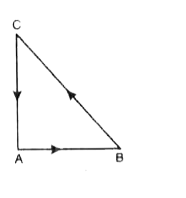"if the magnitudes and direction of three forces acting on a particle are represented by three sides of a triangle taken in order, the particle remains in equilibrium" state whether the statement is true or false ? Solution in Bengali
The correct Answer is:1
Step by step video, text & image solution for "if the magnitudes and direction of three forces acting on a particle are represented by three sides of a triangle taken in order, the particle remains in equilibrium" state whether the statement is true or false ? by Physics experts to help you in doubts & scoring excellent marks in Class 11 exams.
Updated on:21/07/2023Topper's Solved these Questions
- VECTORBOOK - CHHAYA PUBLICATIONCHAPTER - VECTOREXERCISE - EXERCISE (Short Answer Type Questions-I)
11 Videos
- VECTORBOOK - CHHAYA PUBLICATIONCHAPTER - VECTOREXERCISE - EXERCISE (Short Answer Type Questions-II)
2 Videos
- VECTORBOOK - CHHAYA PUBLICATIONCHAPTER - VECTOREXERCISE - EXERCISE (Multiple Choice Questions)
44 Videos
- THERMOMETRYBOOK - CHHAYA PUBLICATIONCHAPTER - THERMOMETRYEXERCISE - EXAMINATION ARCHIEVE - WBJEE
1 Videos
- VISCOSITY AND SURFACE TENSIONBOOK - CHHAYA PUBLICATIONCHAPTER - VISCOSITY AND SURFACE TENSIONEXERCISE - EXERCISE (CBSE SCANNER)
9 Videos
Similar Questions
Can the magnitude of the resultant of two vectors of equal magnitude be equal to the magnitude of each vector ? Explain.
View SolutionAngle between the vectors →Aand→B is θ. By resolving them into mutually perpendicular components show that the magnitude of the resultant vector is (A2+B2+2ABcosθ)1/2.
View SolutionWhat is the condition for →A+→B=→A−→B to be valid ?
View SolutionA scientist proposes a new temperature scale in which the ice point is 25X (X is the new unit of temperature) and the steam point is 305X. The specific heat capacity of water in this new scale is (in J⋅kg−1⋅X−1)
View SolutionState and prove Bernoulli's theorem.
View SolutionThree forces start acting simultaneously on a particle moving with velocity, ¯v. These forces are respresented in magnitude and direction by the three sides of a triangle ABC. The particle will now move with velocity

View SolutionThree forces start acting simultaneously on a particle moving the velocity →V. The forces are represented in magnitude and direction by the three sides of a triangle ABC (as shown). The particle will now move with velocity

View SolutionThree forces start acting simultaneously on a particle moving with velocity, ¯v. These forces are respresented in magnitude and direction by the three sides of a triangle ABC. The particle will now move with velocity

View SolutionThe direction of three forces 1N, 2N and 3N acting at a point,are parallel to the sides of an equilateral triangle taken in order. The magnitude of their resultant is:
View Solutionबताइए कि निम्नलिखित कथन सत्य हैं या असत्य| त्रिभुज की तीनों भुजाओं को क्रम में लेने पर उनका सदिश योग्य →0 है।
View Solutionतीन बल →v वेग से चलने वाले कण पर एक साथ कार्य करते हैं । इन बलों के परिमाण और दिशा को त्रिभुज ABC की भुजाओं द्वारा दर्शाया जाता है । कण a का नया वेग होगा -

View SolutionShow that, if three forces acting on a particle can be taken sequentially to form the three sides of a triangle, their resultant is zero.
View SolutionThree forces start acting simultaneously on a particle , moving with velocity, →v . These forces are represented in magnitude and direction by the three sides of a triangle ABC (as shown). The particle will now move with velocity

View SolutionThree vectors of magnitude 3,6 and 6 units are acting along the sides of an equilateral triangle taken in order The magnitude of their resultant is
View SolutionThree forcesstart acting simultaneously on a particle moving with a velocity →v . These forces are represented in magnitude and direction by three sides of a triangle taken in the same order. What now will be the velocity of the particle ?
View Solution
